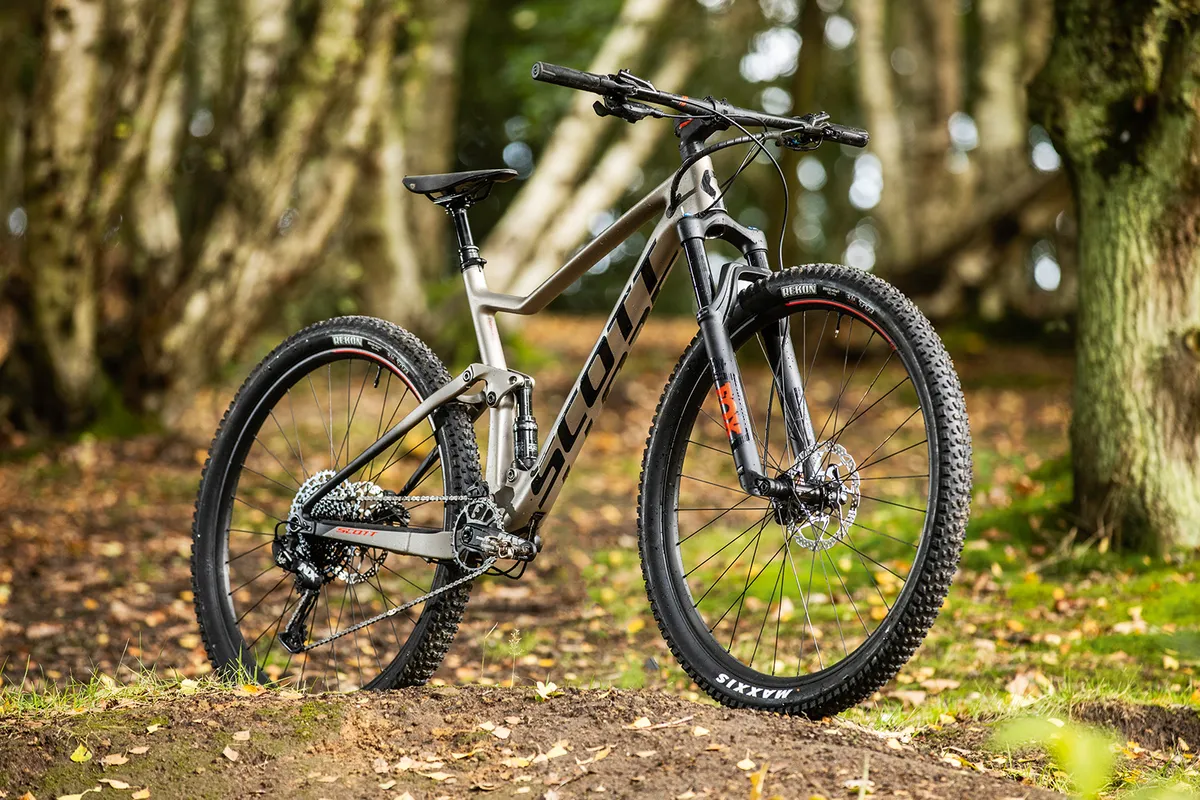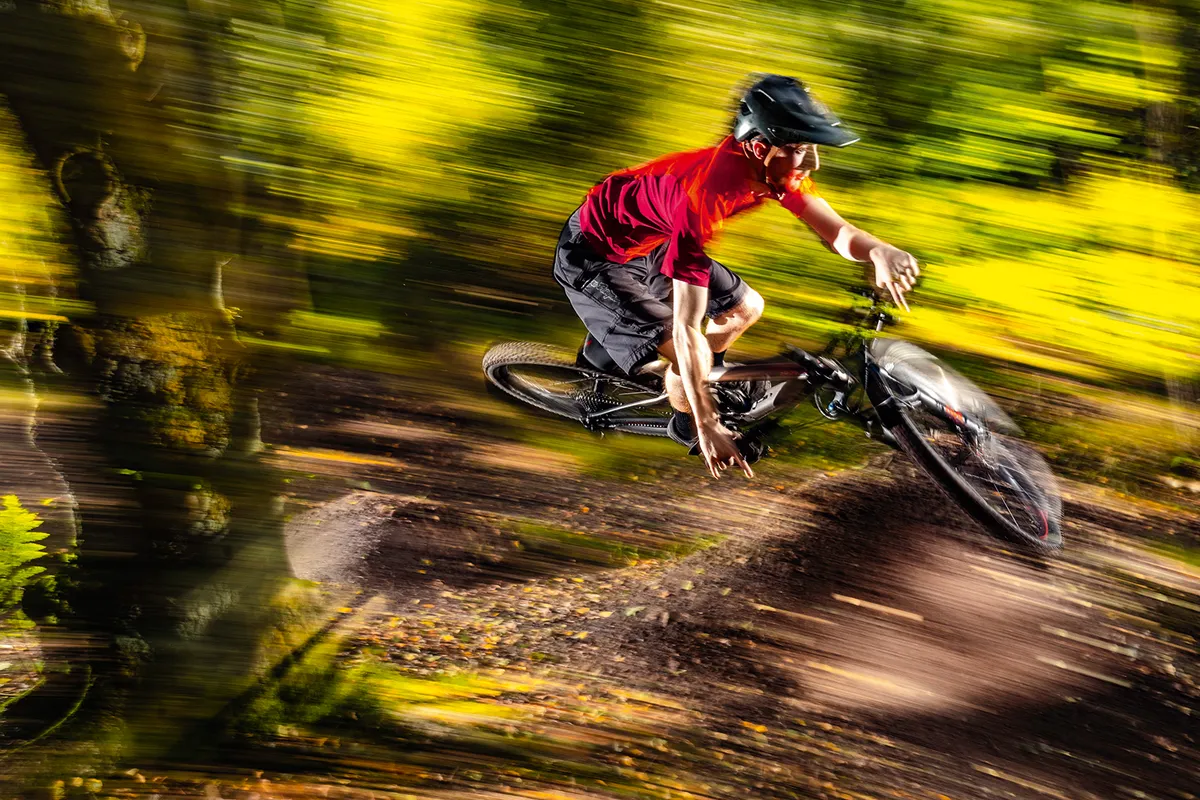Scott’s latest, forward-looking Spark launched in 2017, and the Swiss-designed rig is still on-trend and every bit a modern mountain bike three model years later. The Spark range spans from pure-cross-country race whippets to capable 120mm bikes, all of which share neat chassis details and a unique three-way TwinLoc system that lets you remotely control the suspension at both ends via clever cabling.
Scott Spark 930 frame
The 930’s half-carbon chassis weighs half a kilo less than the full-alloy equivalent. It was one of the first frames to cradle a sealed-bearing, trunnion-mount shock, which boosts sensitivity. You get neat cable routing, plus room for big 2.6in rubber out back, which translates to excellent mud clearance for ‘normal’ tyres.
The front triangle is asymmetric, with the shock offset to the non-driveside. It looks weird from above, but enables Scott to maximise rigidity with a straighter, more continuous frame structure. At the rear there are small, hollow, tubular dropouts for a sleek Boost (148m) axle.
Scott Spark 930 kit

A FIT GRIP-damped Fox 34 fork delivers good traction. Scott has specced the shorter-offset version (44mm) to increase ‘trail’, which acts as a steering stabiliser. In the firmest of the three TwinLoc settings it completely locks out, along with the rear shock. One click of the lever increases low-speed compression support at the back, while another opens up the damping at both ends.
Scott’s in-house brand Syncros provides the wheels, which are a bit soft when turning hard. They spin well though, likely due to the freer, cup-and-cone bearings in their Shimano hubs.
The Maxxis Rekon tyres are the dual- (rather than triple) compound version and roll fast, but lack friction on damp surfaces compared to something like a Forekaster, which was also on test. Shimano’s MT501 brakes are lower-tier offerings, and heavy too, but have sorted power and lever feel.
While the 12-speed NX Eagle drivetrain has good range, SRAM’s cranks can flex under hard loads and the NX cassette is a noticeable weight on the rear wheel. In fairness, though, the next Spark up addresses these issues and is still a good price.
Scott Spark 930 ride impressions

The 930’s geometry and silky suspension deliver the confidence to hit big jumps from the off. Get lairy and the rear end absorbs landings and impacts smoothly, so even on off-piste trails the Spark’s got your back.
While tight and supportive-feeling, the Fox Nude shock lets the bike float over bigger bumps so fluidly that it’s easy to wonder if the engineers got their sums wrong and there’s more rear bounce than the claimed 120mm. Add this sensation to the extra composure from the slacker 67-degree(ish) head angle and low bottom bracket, and the ride feel gets close to that of many 140mm trail bikes. Treating it too roughly reveals that the chassis is a bit less stiff and solid though, especially up front.
Pedalling is dialled, with crank cycles so smooth that the power delivery feels a bit like using an oval chainring (minus the ‘flat spots’ they can bring when stomping hard). Climbing traction is excellent with the suspension run wide open, improving to exceptional in the TwinLoc system’s middle setting.
The 930 isn’t quite as flicky, urgent and feisty as the way lighter Intense Sniper, which was also on test. In fact, the 60mm stem and shorter fork offset combine to dull the steering to the point I’d prefer a more reactive feel. A stubbier stem would likely improve responsiveness easily and cheaply, though.
My biggest niggle was the seated position. It’s not a deal-breaker, but the seat angle tips your weight too far back, so your hips end up behind the crank axle, impacting on balance up steep climbs.
The cluttered handlebar (due to the remote set-up) makes it quite awkward to activate the dropper to shift the saddle and let you adapt to the terrain while pedalling dynamically, too.
Scott Spark 930 geometry
- Seat angle: 73 degrees
- Head angle: 67.2 degrees
- Chainstay: 43.9cm / 17.2in
- Seat tube: 49cm / 19.3in
- Top tube: 63.5cm / 25in
- Head tube: 10.5cm / 4.1in
- Trail: 10.02cm / 3.9in
- Bottom bracket drop: 4.3cm / 1.7in
- Bottom bracket height: 32.7cm / 12.9in
- Wheelbase: 1,183mm / 46.6in
- Stack: 60.24cm / 23.7in
- Reach: 46cm / 18.1in
Product
| Brand | Scott |
| Price | A$5500.00, £3199.00, $3500.00 |
| Weight | 19g |
Features
| Fork | Fox 34 Float Rhythm, 120mm (4.7in) travel, w/ TwinLoc remote |
| Stem | Syncros FL 2.0, 70mm |
| Chain | SRAM NX Eagle |
| Frame | HMF carbon fibre mainframe, alloy rear end, 120mm (4.7in) travel |
| Tyres | Maxxis Rekon EXO TR 29x2.4in |
| Brakes | Shimano MT 501, 180mm rotors |
| Cranks | SRAM NX Eagle Boost DUB, 32t |
| Saddle | Syncros Belcarra 2.0 |
| Wheels | Syncros X-25 |
| Headset | Syncros |
| Shifter | SRAM SX Eagle (1x12) |
| Cassette | SRAM NX Eagle, 10-50t |
| Seatpost | Syncros Duncan 125mm dropper |
| Grips/tape | Syncros |
| Handlebar | Syncros Fraser 2.0, 740mm |
| Rear shock | Fox Nude EVOL w/ TwinLoc remote |
| Bottom bracket | SRAM DUB |
| Available sizes | S, M, L, XL |
| Rear derailleur | SRAM NX Eagle |
